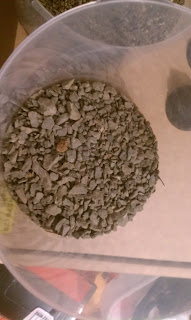My orks have earned lots of praise at each of the public events I've attended, but I have yet to win Best Appearance with them. With my next army, I'd like to raise the bar a little higher and one of the things I know I can do better is basing. I used Woodland Scenics ballast and flock to base my orks, and while it's a quick and easy way to do it, I think they come out a little fake. I'm going to use slightly more advanced basing techniques for my Tau.
The first thing I did was add pieces of pine bark to the 40mm bases of my Crisis Suits, to help make them look more impressive. I even used some of the bark to inform my some posing conversions. After that was finished, I needed to add texture to the base itself.
Every basing guide I've ever read suggests using sand, but I didn't have any on hand. What I do have, and what I thought would look good, is spare kitty litter. I painted the base of an in-progress ork objective marker with some Elmer's glue (PVA), and dunked it into a bowl of fresh litter. Fresh out of the dunk it looked okay to me, but even after letting the glue dry overnight, the granules fell off far too easily to make a suitable base.
Thinking this was due to the little absorbing the glue and not letting it bond the litter to the base, I tried dunking another base and followed it up with a gentle wash of watered down glue to saturate the litter. I let that dry overnight, and was impressed with the results. I painted over the model with some black craft paint, and liked that even more. However, after I had finished, I accidentally pressed too hard on one of the larger granules and it crumbled. It's possible I could make the litter work, but I was already pushing the limits of what I'm willing to do. On to a different material.
 |
The railroad ballast I've been using for my orks is a good size, but too regular. I have some very fine grain sand sitting around, so I mixed the two together and tried dunking a spare model in that. Unfortunately, the sand is so much finer and heavier than the ballast that the only thing noticable on the base is the ballast. This wouldn't work either.
Underneath our deck is bluestone dust, which on its own looked like a very promising basing material. I scooped some up and brought it in to the workbench. Up against a model, however, it was clear that the scale of the stone dust was off. The larger pebbles were too big, and the majority was, obviously, dust. I did try sifting it into different size categories for use in terrain projects - I'll definitely be using these larger pebbles for something.
 |
| These pebbles will make some terrain piece very proud someday. |
Finally, last night I noticed a pile of roadside sand that has been quietly building up at the bottom of our driveway. I scooped some of that and brought it inside, and was very excited to see a perfectly usable bowl of basing material. Just to test, I dunked another spare model into the sand and examined the result. I was immediately sold.
 |
| Jackpot! |
So, my basing odyssey complete, here's the bulk of my Tau force, based and ready for primer. The Suits have no weapons because I plan on magnetizing them but wanted to get them tabletop ready first.
On a side note - who the heck layed out the sprues for all the Tau models? The Crisis heads are connected right on the top, such there is always a dimple that needs to be filled; the Firewarriors are pressed with a mold line running straight across the crown of their helmet, so that every single one needs to be carefully cleaned up; and the Devilfish don't even come close to fitting properly and require a ton of filing and sanding. Maybe I'm spoiled by the newer designs like the Dakkajet, and maybe I don't know enough about injection molding plastic, but these seem like basic things that any experienced sprue designers should be able to avoid.
 |
| Every head requires filling and sanding. Every single one! |
 |
| Look at all the sanding the Devilfish needed. |
 |
| This is the paint I intend to use as a primer. |


No comments:
Post a Comment